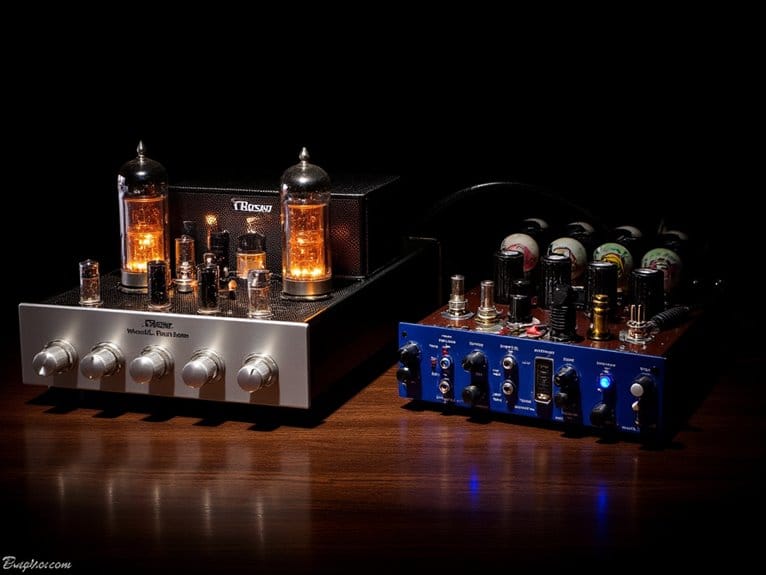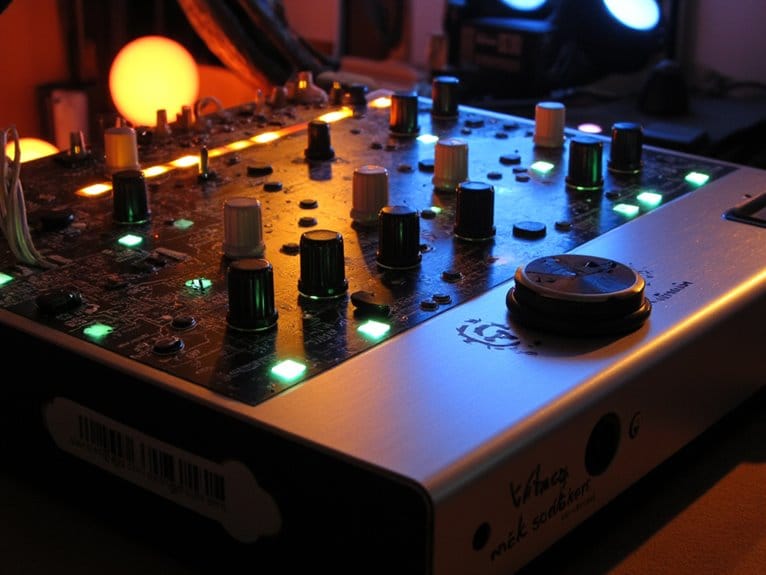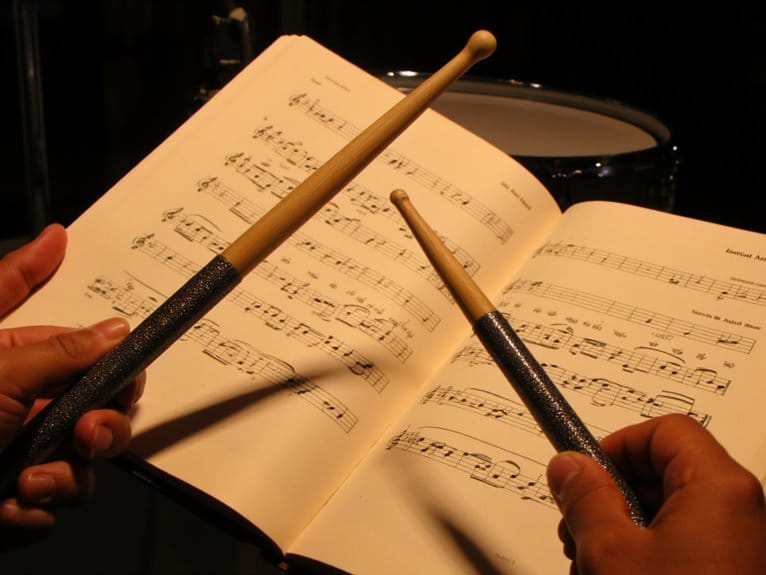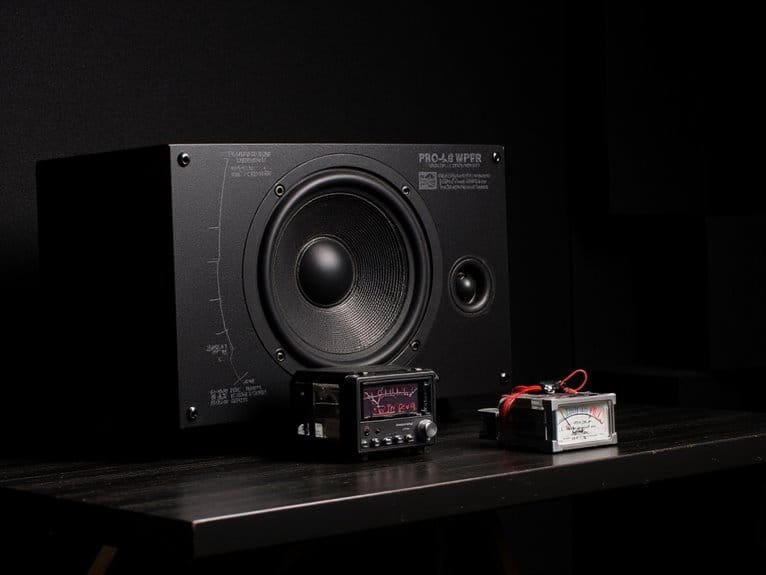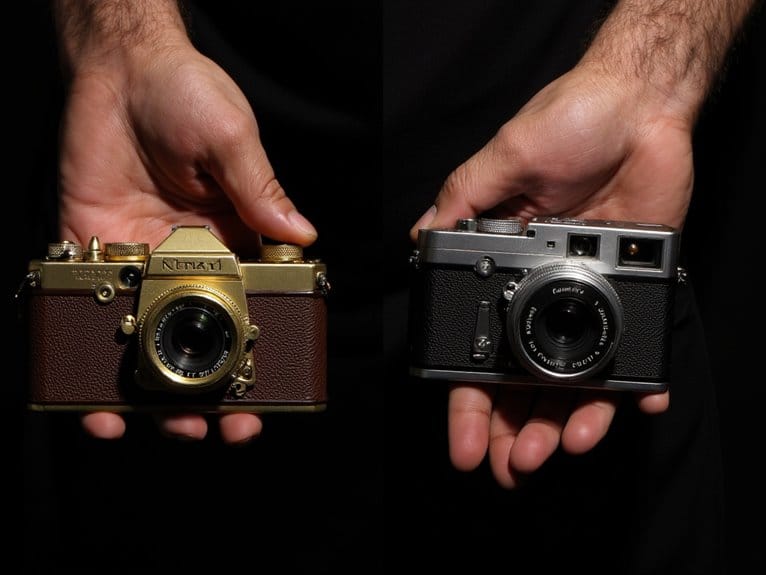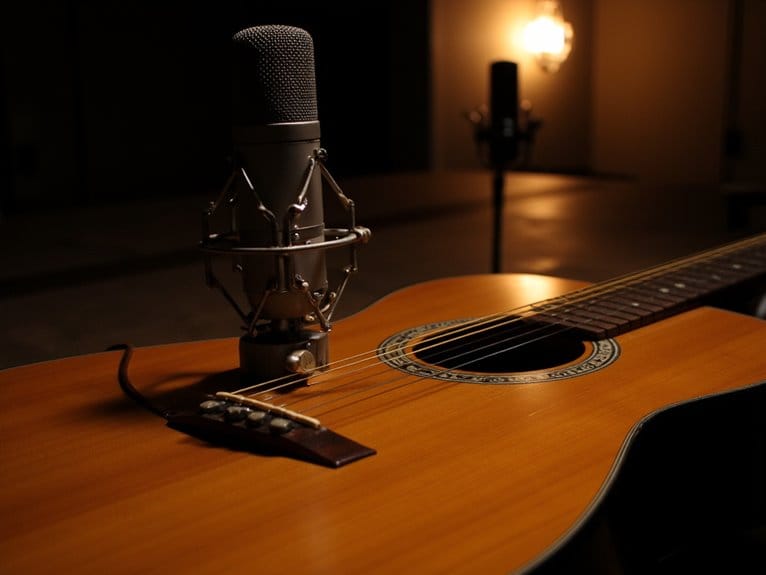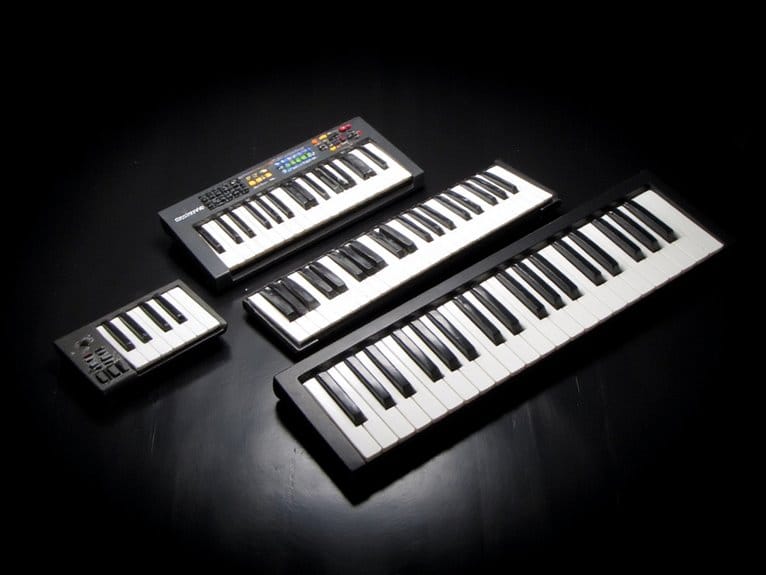Guitar Preamp Vs Power Amp: Understanding the Signal Chain
Your guitar’s preamp converts weak pickup signals into line-level voltages while shaping your fundamental tone through EQ controls, whereas the power amp boosts that processed signal to drive your speakers and adds its own tonal characteristics. You’ll want your preamp early in the signal chain for foundational processing, with solid-state units typically outputting 100-600Ω compared to tube preamps exceeding 2,000Ω, requiring careful impedance matching. Understanding these distinct roles reveals advanced tone-shaping possibilities.
We are supported by our audience. When you purchase through links on our site, we may earn an affiliate commission, at no extra cost for you. Learn more.
Notable Insights
- Preamps convert weak pickup signals to line level and shape tone early in the signal chain.
- Power amps provide final amplification to drive speakers and must be positioned last before speakers.
- Preamp distortion creates tight, compressed saturation while power amp distortion adds musical warmth and compression.
- Impedance matching is critical – power amp input should be 10x higher than preamp output impedance.
- Proper signal routing places preamps early for tonal foundation, before modulation and time-based effects.
Core Functions and Signal Processing Roles
When you’re trying to understand the difference between guitar preamps and power amps, I’ve found it’s easiest to think of them as two distinct workers in an audio assembly line, each with their own specialized job that transforms your guitar’s signal in fundamentally different ways.
Your preamp acts as the initial sculptor, converting those weak pickup signals into robust line-level voltages while shaping your tone through EQ controls. Different preamp types offer varying degrees of transparency or coloration, depending on your sonic goals. Preamps are typically positioned early in the signal chain to establish the foundation for all subsequent processing.
The power amp then takes over, providing the massive voltage boost needed to drive speakers while adding its own tonal characteristics through saturation and dynamic response. Various power amp configurations handle this final amplification differently, influencing everything from headroom to harmonic content in your signal chain. Most guitar amplifiers house both components in a single unit for convenience and optimal signal matching.
Technical Specifications: Impedance and Amplification Methods
Although impedance might sound like one of those intimidating electrical engineering terms that’ll make your eyes glaze over, I’ve learned it’s actually the key to understanding why some preamp and power amp combinations sound incredible while others fall flat on their face.
Impedance matching separates legendary audio setups from disappointing disasters that leave you wondering where your tone went wrong.
When you’re matching components, you want your power amp’s input impedance to be at least 10 times higher than your preamp’s output impedance—this creates proper impedance bridging that preserves your frequency response.
Here’s what you need to watch for when matching components:
- Solid-state preamps typically output 100-600Ω, making them incredibly forgiving to match
- Tube preamps can exceed 2,000Ω output impedance, requiring careful consideration
- Power amp inputs range from 10kΩ-100kΩ, with tube amps typically offering higher values
- Poor matching causes frequency response anomalies that’ll kill your tone’s clarity
For example, a 5-watt tube amp using EL84 tubes with 12AX7 preamp configuration will have different impedance characteristics that affect both the brightness and overall tonal response compared to configurations using 6V6GT power tubes. This variation in tube types can significantly influence how the amp interacts with your guitar, leading to unique tonal qualities that suit different playing styles. Many guitarists prefer using practice tube amps for home due to their authentic sound and dynamic response, allowing for a more nuanced playing experience.
Signal Chain Placement and Stage Interaction
If you’ve ever wondered why your carefully crafted tone sounds muddy or harsh despite having quality gear, the culprit’s probably hiding in your signal chain placement—something I learned the hard way after years of randomly connecting pedals and wondering why my rig sounded inconsistent. Your signal path dramatically affects impedance matching and signal integrity, with preamps needing early placement to establish tonal clarity before subsequent processing.
| Signal Chain Position | Preamp Placement | Power Amp Placement |
|---|---|---|
| Early Chain | After tuner/compressor | Never recommended |
| Mid Chain | Acceptable for cleanup | Rarely beneficial |
| Late Chain | Can reduce noise | Standard practice |
| Effects Loop | N/A | Between preamp/power sections |
| Final Position | Avoid | Always last before speakers |
Proper coordination between these stages guarantees your processed signal reaches maximum amplification levels without unwanted distortion. Many bass preamps feature multiple outputs including XLR and 1/4-inch connections that provide enhanced versatility for both live performance and studio recording applications. Just like drummers prefer hickory construction for its superior durability and shock absorption during intense sessions, choosing quality materials and proper signal routing in your guitar rig ensures consistent performance under demanding conditions.
Distortion Characteristics and Tonal Differences
Beyond proper signal routing lies the heart of what makes each amplification stage truly distinct—the way preamps and power amps generate distortion creates fundamentally different sonic personalities that’ll shape your entire playing experience.
Preamp distortion occurs early in your signal chain, clipping through 12AX7 tubes to produce tight, compressed saturation that’s perfect for metal’s precise note articulation.
Meanwhile, power amp distortion happens when EL34s, 6L6s, or other output tubes get pushed hard, creating warmer breakup with natural compression and midrange punch.
Here’s how these distortion types affect your tonal shaping:
- Preamp clipping delivers aggressive brightness that cuts through dense mixes
- Power amp saturation provides musical warmth that responds to your playing dynamics
- Tube sag creates expressive compression that breathes with your performance
- Combined distortion stages offer infinite tonal possibilities from subtle crunch to heavy saturation
Practical Applications and Setup Optimization
Understanding how distortion shapes your tone means nothing if you can’t properly implement these concepts in real-world scenarios, which is why mastering the practical setup between preamps and power amps becomes essential for achieving professional results.
Professional tone requires more than understanding distortion theory—it demands mastering the practical preamp and power amp setup techniques that deliver real results.
I’ve learned that essential setups require careful signal chain placement, positioning your preamp before modulation and time-based effects, with the power amp always at the end.
Ideal matching involves balancing preamp output voltage with power amp input gain, which I’ll admit took me years to perfect through trial and error.
You’ll want to use your preamp for tonal shaping while letting the power amp handle final amplification, ensuring proper impedance matching between components and maintaining signal integrity through quality cabling. When recording your guitar signal, consider that affordable audio interfaces can provide professional-grade preamps with similar sound quality to higher-end models, making them excellent options for capturing your carefully crafted preamp tones.
Just as with microphones, understanding signal-to-noise ratios above 80 dB becomes crucial for maintaining professional audio quality throughout your entire signal chain.
Frequently Asked Questions
Can I Use a Preamp Without a Power Amp for Home Recording?
You can absolutely use a preamp without a power amp for home recording. Preamp functionality includes boosting your guitar signal to line level, while recording alternatives like audio interfaces and amp modeling software replace traditional power amp needs.
What’s the Typical Cost Difference Between Quality Preamps and Power Amps?
You’ll find preamp investment typically ranges $100-$1000, while power amps cost $200-$1500+. Amplifier pricing shows power amps generally cost more due to higher wattage demands and robust components needed for output stages.
Do Solid-State and Tube Preamps Require Different Maintenance Schedules?
You’ll find tube preamps need regular tube replacements every few years and careful monitoring, while solid-state preamps offer superior longevity with minimal preamp maintenance requirements beyond occasional cleaning and inspections.
On a final note
You’ve now got the roadmap to navigate your guitar’s signal chain like a pro, though I’ll admit it took me years to truly grasp these concepts myself. Your preamp shapes the tone, character, and initial gain structure, while your power amp delivers the muscle to drive your speakers with clean headroom or natural compression. Understanding this fundamental relationship will transform how you approach your entire rig setup and troubleshooting.

